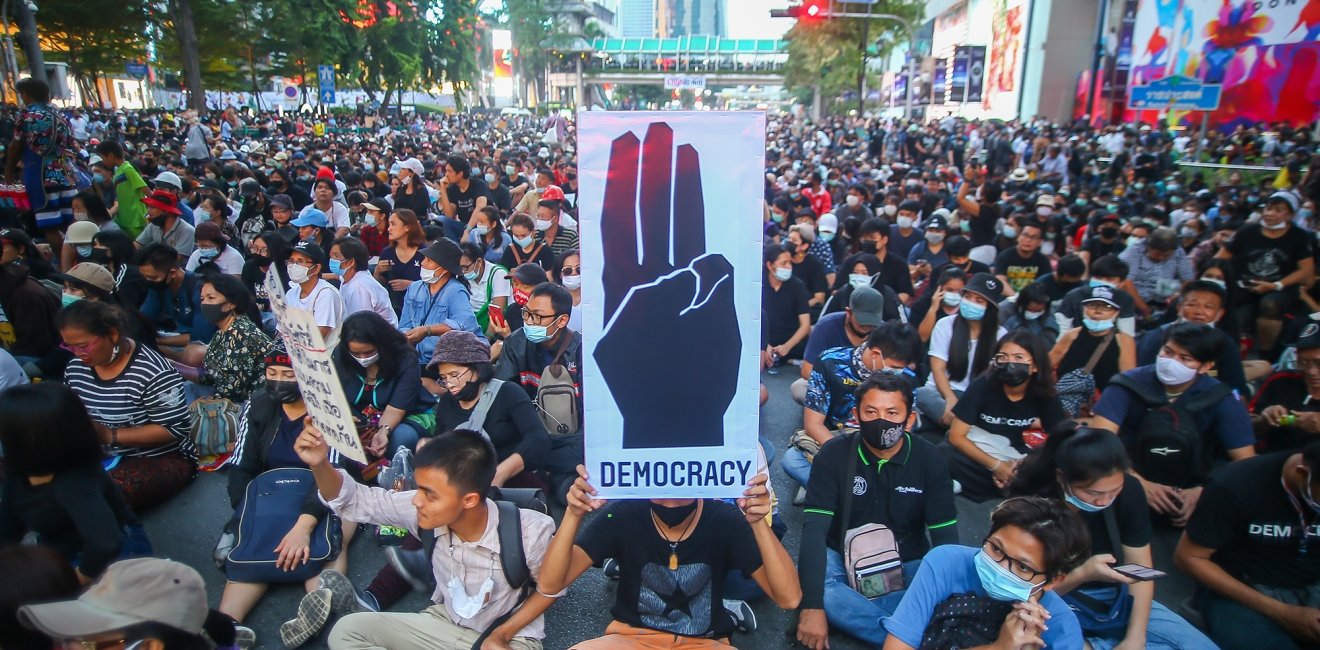
A blog of the Indo-Pacific Program
Over the last several weeks the streets of Thailand’s capital, Bangkok, have been engulfed by thousands of demonstrators, most of them young, demanding one basic thing — democracy. This followed months, even years, of similar demonstrations in Hong Kong. These are contemporary scenes in a profoundly important drama that has been playing out in Asia over many decades — the contest between democracy and autocracy over how Asia will be governed.
The deep cultural foundations of Asian societies and polities are entirely authoritarian (and patriarchal). The idea that the population as a whole could exercise self-rule by choosing their own leaders and laws was an entirely novel idea generated in the West — beginning with the Greeks. When European states empowered by modern technologies and economies began to penetrate and dominate Asia, they brought with them this exotic idea of democracy. Sometimes such ideas were deliberately introduced (mainly by Britain and America) but more often they were the unintended byproduct of exposing Asians to Western education and culture.
By the late 19th and early 20th centuries, some young Asians began a determined effort to transplant democracy to Asian soil. Sun Yat-sen tried it in China as the last imperial dynasty tottered and idealistic young Japanese introduced the same ideas into Japan as the Shogunate (military rule) gave way to the Meiji Restoration. By the 1930s, both efforts were supplanted by military dictatorships. The triumph of communism in China and North Korea cemented in power a newer, more sophisticated, form of dictatorship. South Korea came under traditional military rule, as did Taiwan.
Today, there are intense debates regarding provisions of the constitution, but the essential decision that Japan will be a democracy is unquestioned.
But that was not the end of the story. In postwar Japan, the U.S. occupation authority put in place democratic institutions including a written constitution. Remarkably, these western political institutions imposed by a foreign army took root. Today, there are intense debates regarding provisions of the constitution, but the essential decision that Japan will be a democracy is unquestioned. Something analogous happened in India when British colonial authorities left behind democratic institutions that have been adopted and treasured by Indians. In the late 1980s, two equally remarkable events occurred. In South Korea and Taiwan, powerful military dictatorships voluntarily initiated a transition to constitutional democracy. In both countries, the changes took root and have remained vibrant.
Southeast Asia moved from colonialism to independence after World War II. By 1960, there were ten independent countries exhibiting a kaleidoscope of political forms. But, by 1980, authoritarian regimes were the norm, with the partial exception of Malaysia. But again, time brought some remarkable changes. In Burma (now Myanmar), a formerly imprisoned opposition leader became the new head of an elected government. In the Philippines, the Marcos dictatorship was overthrown and democracy restored. Most consequentially, in Indonesia (the region’s largest country with 230 million people), a long-established military dictatorship gave way to a new democracy at the end of the 1990s. Much like India, Indonesians with their myriad divisions and problems, have embraced democracy — which is now remarkably well-rooted in the world’s largest majority Muslim country. In Myanmar, Malaysia and the Philippines democratic governance is partial and flawed. But it is not a facade; legislatures convene, elections are held, votes are counted, and democracy has become part of the cultural fabric.
In some heady moments of optimism during the Tiananmen protests (1989), there were serious hopes that China, itself, might adopt democratic reforms. Those hopes have been spectacularly dashed.
All this said, the challenge to democracy in Asia is daunting. In some heady moments of optimism during the Tiananmen protests (1989), there were serious hopes that China, itself, might adopt democratic reforms. Those hopes have been spectacularly dashed. When the current president/party leader, Xi Jinping, took power in 2012, he began a radical centralization of authority in the hands of the communist party and in his own hands. He is now, effectively, China’s president-for-life — a new emperor. In the process, Xi has enlisted the latest innovations in artificial intelligence and surveillance technologies to establish a degree of control over individual citizens that is truly Orwellian — the first “total surveillance state” the world has ever known. And in recent days China has stripped Hong Kong of the last vestiges of autonomy provided under the “one country two systems” formula.
The challenge China poses to nascent democracies is obvious. Beijing is exporting technical know-how to autocrats in Asia and Africa — a tool kit for strengthening central control. Even more important, growing Chinese power sends an unmistakable message to Southeast Asia and beyond— China will be Asia’s dominant power and China’s way of doing things will become your way as well, whether you like it or not.
The tide of popular sentiment across Asia (particularly among the young) increasingly favors democracy. People want to live in a society where they have a voice. Those views are as intensely held in Bangkok as they are in Paris or Los Angeles. But the forces that will take Asia in a very different direction are growing more powerful by the day. How this ultimately plays out will shape the course of the 21st century.
Follow the Asia Program on Twitter @AsiaProgram. or join us on Facebook.
The views expressed are the author's alone, and do not represent the views of the U.S. Government or the Wilson Center. Copyright 2020, Asia Program. All rights reserved.
Author

Adjunct Professor, Johns Hopkins University; Former Professor of National Security Policy, National War College and Deputy Staff Director, Senate Select Committee on Intelligence

Indo-Pacific Program
The Indo-Pacific Program promotes policy debate and intellectual discussions on US interests in the Asia-Pacific as well as political, economic, security, and social issues relating to the world’s most populous and economically dynamic region. Read more





